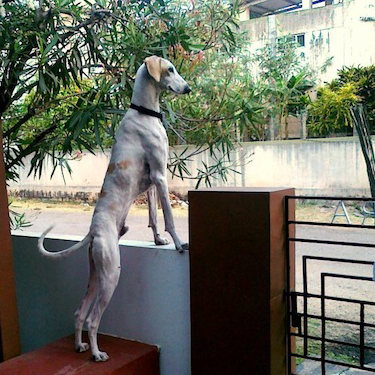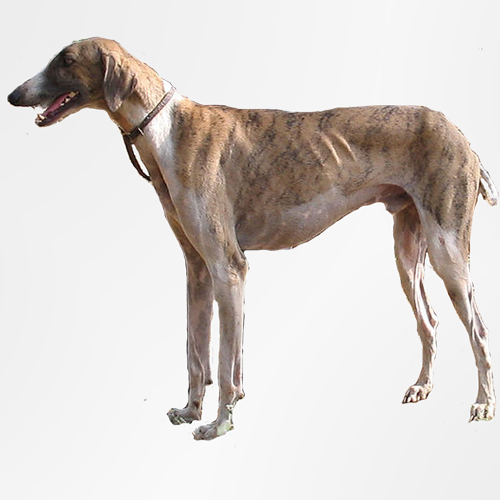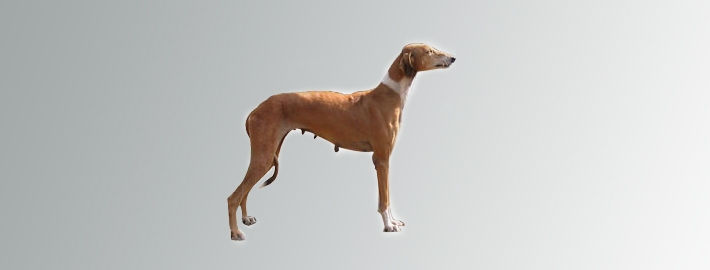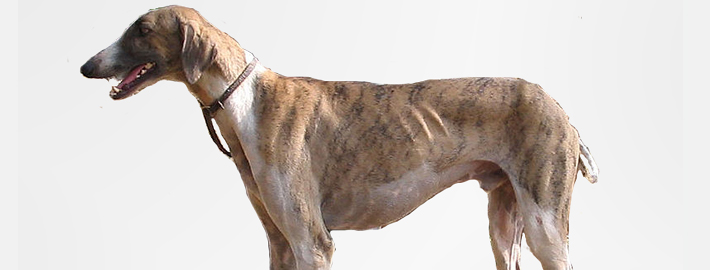What makes the Mudhol Hound Unique?
Aloof and independent but highly intelligent and a keen hunter, reserved with strangers. Only his master can touch him. Can and will protect that which it holds dear if need be, he needs a great deal of socialization starting from a young age. Owners of this breed need to be calm, with an air of gentle, but firm authority over the dog. The rules of the house must be made clear in a way the dog can understand.
One of the most unique aspects about Mudhol Hound is the various names by which this breed is known across the country. We have not come across any other dog that has such a vast and varied nomenclature. This sight hound is called Mudhol in the south, it was called Caravan hound by the British and Karwaani by the local villagers who owned the dog.
Breed Groups
Page Contents

Is the Mudhol Hound Right For You?
Mudhol Hounds are good family companions and develop a special bond with one person in the family. These Hounds may not be the right breed for younger children but they bond well with the older children and are warm and affectionate towards them. Your Mudhol might do well with other dogs but will not be tolerant towards smaller pets because of their high prey drive. This breed has an abundance of energy and will need regular exercise to ensure agility and give its mind the required stimulation. So, they are not the perfect breed to keep in an apartment.
They are intelligent and devoted dogs. Though they can be a little reserved at times but do not take this as a sign of being unfriendly they are just shy to begin with. If you are stranger in the house and try to touch this dog he or she might get irked and snap. They need socialization with a lot of people and sound on regular basis.
You have to keep in mind that they will not respond well to harsh treatment and you always have to deal with kindness and respect as he or she might turn aggressive if it is not catered to well.
In 5 Words
- Alert
- Courageous
- Elegant
- Graceful
- Loyal

Characteristics
Learn About the Mudhol Hound
Description
General Description
The Mudhol Hound’s head is long and narrow and broad between the ears with a tapering muzzle. The jaws are long and powerful, but deceptively weak looking. The nose is large and may be black or liver colored. The ears are moderate in size and hang close to the skull. The eyes are large and oval in shape, being dark hazel to amber in color. The expression is a piercing gaze. The neck is long, clean and muscular and fits well into the shoulders, which are well-laid back. The forelegs are long, straight and well-boned. The back is long, broad and well-muscled with a slight curve over the loin. The loins are wide and deep. The chest is strong and deep with well sprung ribs. The abdomen is tucked in. The hindquarters appear wide and well-muscled. The tail is strong at the base, not too long, set low and carried in a natural curve. It should never be carried curled over the back. The gait is high-footed, flexing all four legs. The coat may be short and smooth or of a silky texture, sporting fringes on the ears, legs, backs of thighs and tail. All colors and combinations of colors are seen.
Short History of the Mudhol Hound
The Mudhol was introduced to the Deccan Plateau of western India from Central Asia and Arabia, and can thus be considered a direct descendant of the Saluki or Tazi. This region covers parts of the states of Karnataka, Maharashtra, and, to a lesser degree, Andhra Pradesh. The breed is popular in and around Mudhol Taluk of Karnataka and thus the breed got the name as Mudhol hound.
Shrimant Rajesaheb Malojirao Ghorpade of Mudhol (1884-1937) of the Mudhol State is credited with reviving the Mudhol hound. He noticed local tribal people using these hounds for hunting. Using selective breeding, he was able to restore the royal Mudhol hound. On a visit to England in the early 1900s, the Maharaja of Mudhol State presented King George V a pair of hounds, which popularized the Mudhol hound breed.
Temperament
The breed is above all a working hound, capable of providing an excellent performance in the field on a consistent basis, under gruelling conditions that would decimate most other dogs. They are elegant, graceful and courageous. Its physical strength couples with great speed and plenty of stamina to allow it to catch and kill several types of game, from hare to blackbuck, over rough country. It is not an ideal dog for the apartment dweller, as it needs a great deal of space and exercise; although if arrangements are made to exercise the dog regularly in a sufficiently large, safely fenced area, it may do well in a flat or any other dwelling.
The breed, if treated with kindness and respect, can be exceptionally loyal. They are not very friendly, and do not like to be touched by strangers. However, a Mudhol should never be aggressive, as this sort of temperament is not ideal for a hunting dog, which must tolerate other dogs and human beings, especially when they are not intruding on his territory. It makes a reasonable watch dog, and can protect that which he holds dear, should the need arise. He should always be treated in a kind, consistent, fair, and respectful manner, otherwise he may develop a nervous or vicious nature—either of which are difficult to live with.
Caring for Your Mudhol Hound
General Health
The Mudhol Hound is one of the healthiest breeds around and is not prone to any specific ailment. Their long lineage and the ability to face the harsh Indian weather has made them not only versatile but have also helped them to successfully avoid ailments as well.
The most common disease in the Mudhol Hound is isssues related to the skin, they do not have fat layer in the body, which makes them vulnerable to rain and cold as their can develop chilly bites easily. In addition in harsh sun can give them a sunburn so a sunscreen will not be a bad option.
The other problem that can be seen in a Mudhol is of marasmus, in this the liver malfunctions and the food is not absorbed in the body. In such a case your pet might eat a lot but or she will not gain weight in fact on the contrary it might just look malnourished.
Grooming & Bathing
None is required for the smooth variety. A weekly brushing for the feathered is all that is needed. The Mudhol Hound is an average shedder.
Exercise & Training
Being a sighthound, the Mudhol needs a tremendous amount of daily exercise in order to remain physically and mentally sound. Daily long walks where the dog is made to heel beside or behind the person holding the lead are essential, coupled with long, weekly or bi-weekly running sessions in a large, enclosed, safe area. Never allow a Mudhol off leash on unfenced ground, as it has the ability to become selectively deaf to its master’s calls should anything catch its attention and trigger a chase. Exercise is one of the key ingredients to a well-adjusted Mudhol, so if you cannot provide enough of it, please do not think of owning this breed.








